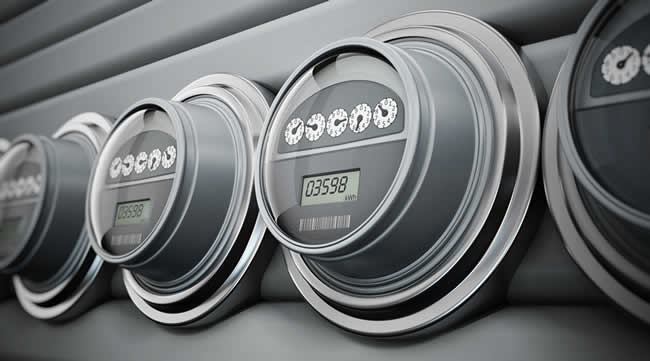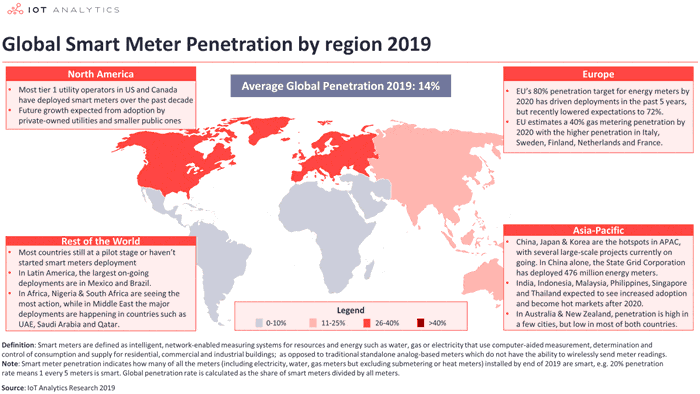Smart metering is the usage of smart meters, mainly in the context of advanced metering infrastructure (AMI) deployments of utilities in the scope of smart grid projects, smart homes, smart buildings, smart offices, and the evolution of smart cities.
Yet, although smart metering today is mainly covered in the -smart – energy metering projects of companies in the utility industry in relationship with residential customers, the usage of smart meters stretches further.

Businesses also use smart meters to keep track of the energy they consume which enables them to take measures to change it. Moreover, in some environments, smart metering is used in a pervasive way, whereby one can, for example, see the cost of energy in different areas of a building and track the energy quality in these different areas.
As mentioned in an interview on critical power facilities, pervasive metering offers a huge opportunity to track energy usage which encompasses both energy quantity and energy quality. Smart tariff meters help in keeping track of energy expenses and enable cost reduction, common needs in buildings, utilities and industries.
Smart metering – the essence of smart meters
Back to smart meters. Although the term smart meter is most often used for smart electricity meters, since this is where many projects across the globe have been rolled out or are being rolled out, smart meters are also used for the consumption of water or natural gas.
At the bottom of this article, there are some forecasts for all types of smart meters with the market of smart electricity meters, among others driven by edge computing.
By leveraging IoT technologies, smart meters can provide (real-time) data for various purposes and types of users. For utility companies, smart meters initially meant a way to change their rate models, in alignment with costs and demand, and to remove the costs of manual meter reads.
Since then, they detected new opportunities, for instance, by leveraging big data analytics. Gradually there was also a shift from cutting costs as the main benefit to finding benefits for consumers and organizations alike, although there are certainly discussions regarding the – perceived – benefits for consumers and the perceived downsides. Smart metering projects often have encountered resistance in a consumer context, among others because of privacy concerns.
Smart meters aren’t just deployed for billing purposes and to keep track of energy consumption. Electric utilities, for instance, also use them to monitor power quality and enhance the power flow, improve service, and intervene faster in case of issues such as outages. In the context of other parts of the grid, smart meters are also used for substation automation, line sensing and equipment control. In utilities, the adoption of IoT will continue to be boosted by electricity smart metering per Gartner.
The term smart metering is also used for other forms of remote measurement, beyond the scope of electricity, water, and gas. Think about the remote measurement of parameters regarding all sorts of machines and physical environments.
Smart meters essentially are called smart because they enable two-way communication, can communicate with other devices such as smart appliances and household equipment and can be remotely monitored and controlled by the distribution service operator (DSO).
As in all connected environments, this has equally raised questions and concerns concerning cybersecurity.
Smart meters can measure both the amount of energy that is consumed as the amount of energy that is injected into the network. The data is sent at regular intervals to distribution network operators who, among others, use it to map consumption peaks and gain insights, while passing it on to the energy supplier for invoicing purposes. One of the promises of smart meters is a more precise measurement and invoicing, often also in combination with dynamic pricing.
With ongoing electrification, digitalization and decentralization and rising demand for power, along with the addition of new energy sources, smart meters are deemed critical for the electricity sector and are seen as the basis which is needed for the further deployment of renewable energy sources (also in consumer environments), electric cars and the usage of grid-connected devices such as batteries and smart heat pumps.
LPWAN and other wireless technologies in smart metering
Smart meters dispose of embedded communication possibilities. Several solutions are used, including power line communications (PLC), wireless low-power wide-area network (LPWAN) standards and other wireless options, including RF Mesh (Radio Frequency mesh-based systems, typically deployed for smart energy management applications).
Along with asset tracking, smart metering is the main driver of the LPWAN market. According to research, smart meters deployed by energy and water utilities will be the second largest vertical IoT application in 2023, contributing over one-third of the global LPWA device connections.
Mainly LoRa, Sigfox, and NB-IoT seem to have been a good fit here. Some examples of deployments:
- In Sweden, Telia was able to show that the TCO of NB-IoT was less than that of PLC and RF Mesh for last-mile connectivity. Along with its system integration partners, Telia is converting and managing more than 2 million of the 5.4 million electric meters across the country with cellular IoT.
- In France, LoRa is being used by Nova Veolia and its subsidiary Birdz, in collaboration with Orange Business Services, to connect over 3 million water meters to the LoRa network of Orange. Their goal is also to read more than 70% of their meters remotely by 2027.
- In Japan, 850,000 NICIGAS (Nippon Gas) gas meters across the country will get a smart makeover by the end of FY2020, thanks to a retrofitted gas meter reader developed by UnaBiz and SORACOM. The gas consumption data are transmitted to NICIGAS’ IoT data platform, via Sigfox’s Japan-wide 0G wireless network.
Looking at wireless technologies to choose from as networking platforms for smart meters in the European market, Berg Insight (PDF) sees an important role for NB-IoT and advanced mesh radio technologies.
The rapid development of new technologies for industrial Internet of Things has a major impact on the smart metering market in Europe, Berg Insight states, adding that DSOs planning for new smart grid projects and rollouts in the 2020s have a wide range of increasingly sophisticated wireless technologies that have major advantages compared to PLC technologies which dominated the first wave of smart electricity deployments.
The company zooms in on NB-IoT and on the fact that there is also room for the next generation of advanced mesh radio technologies in the European market.
Smart metering – smart meter deployments across the globe
Finally, let’s take a look at the state of smart meter deployments and expectations for the coming years.
The overall smart meter market (electricity, water, gas, residential, commercial and industrial)
According to research by IoT Analytics (end 2019), 14 percent of all meters in electricity, water, and gas across the globe are now smart meters.
IoT Analytics defines a smart meter as ‘an intelligent and network-enabled measuring system for resources and energy such as water, gas or electricity that use computer-aided measurement, determination, and control of consumption and supply for residential, commercial and industrial buildings.’ In other words: the numbers concern all smart metering scenarios, not just smart electricity meters for consumers, for instance.
Smart meters are one of the most mature and widely adopted IoT applications the research firm reminds, expecting the installed base of smart meters for electricity, gas, and water to surpass the 1 billion mark within the next two years (so, before November 2021) with the number of shipped smart meters expected to grow 7 percent per year to exceed 200 million by 2024.
The market for smart electric meters – advanced metering infrastructure
According to Navigant Research, the global penetration rate of smart electricity meters is expected to near 59 percent by 2028.
This growth is mainly driven by continuing investments in grid intelligence, security, and edge computing technologies.
In an announcement regarding a report that analyzes the global market for smart electric meters, or advanced metering infrastructure, Navigant Research adds that in 2019, the global penetration rate of smart meters (electricity) was 41.2 percent in 2019.


